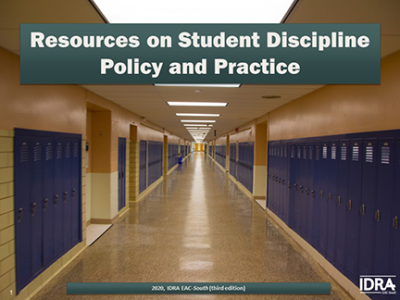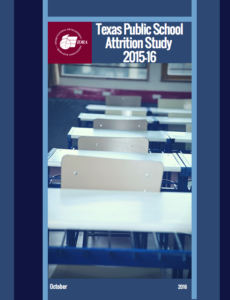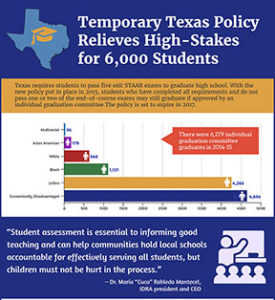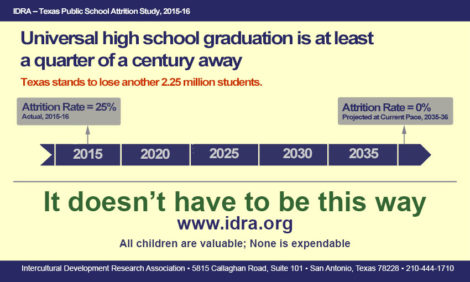Web Story Released with the IDRA Attrition Study (Updated 2022)
Zero tolerance policies likely contribute to high attrition rates of Black students and Latino students in Texas public schools. In an additional analysis to IDRA’s annual attrition study released earlier this month, IDRA compared the trend lines for attrition rates to those of discipline data for the state of Texas.
The historical high attrition rate for each race-ethnicity group parallels the period when zero tolerance policies gained momentum in Texas. Lower attrition rates for each group coincide with Texas’ legislative attempts to relax zero tolerance approaches under specific circumstances.
Zero tolerance was originally used for drug enforcement, but it expanded in public schools into a policy of punitive and exclusionary consequences for student infractions, regardless of severity or circumstances. While zero tolerance practices vary, the general approach is the same: removing students who disrupt the learning environment. However, there is no research to support that zero tolerance makes schools any safer.
In Texas, data are collected on several types of disciplinary actions: in-school suspension, out-of-school suspension, referral to disciplinary alternative education programs (DAEP), referral to juvenile justice alternative education programs (JJAEP) and expulsion. A review of these data show disproportionately high disciplinary action rates for students of color and males.
“This has huge consequences as the data show nationally that children are up to 10 times more likely to drop out of high school if they’ve been expelled or suspended. They also are much more likely to experience academic failure.”
– Dr. María “Cuca” Robledo Montecel, IDRA president emerita
In-School Suspension
Each year from 2005-06 to 2018-19, Black students received in-school suspensions nearly two times the rate they comprised in the total population.
- In 2018-19, Black students represented 13% of public school enrollment in Texas, but 26% of students receiving in school suspensions.
- In comparison, white students represented 27% of enrollment but 22% of students receiving in-school suspensions. On average, 26% of Black students are suspended compared to 8% of white students.
- Latino students represented 53% of enrollment and 49% of students suspended. On average, 9% of Latino students received in school suspensions.
- Males represented 51% of the 2018-19, total enrollment but 71% of the students suspended in-school. On average, 12% of males compared to 6% of females received in-school suspensions.
Out-of-School Suspension
As with in-school suspensions, Black students received out-of-school suspensions significantly more than the rate they comprised in the total population from 2005-06 through 2018-19, school years.
- In 2018-19, Black students represented 13% of public school enrollment in Texas, but 32% of students receiving out-of-school suspensions.
- White students represented 27% of enrollment but 14% of students receiving out-of-school suspensions. On average, 11% of Black students are suspended compared to 2% of white students.
- Latino students represented 53% of enrollment and 50% of students receiving out-of-school suspensions. On average, 4% of Latino students received out of school suspensions.
- Males represented 51% of the 2018-19, total enrollment but 70% of the students receiving out-of-school suspensions. On average, 12% of males compared to 6% of females were suspended.
Other Forms of Discipline
Annual discipline summaries also provide information on students removed from the classrooms in several other categories including disciplinary alternative education program (DAEP), juvenile justice alternative education program (JJAEP) and expulsions. DAEPs were established for criminal offenses – drug related activities, gun violations and assault – all violations that had been punishable by referral to the Texas JJAEP system.
Because not all areas of the state had access to JJAEP facilities, DAEPs were presented as a means for creating options that would remove serious offenders from regular school settings, including many small school districts and those rural communities where no JJAEP facilities existed.
Instead, students as young as six years old were removed from their kindergarten classes and sent to DAEPs for “discipline” problems. And students often can’t catch up academically because many of their teachers are not qualified to teach them, and those who are qualified are unable to coordinate with the students’ “sending” schools.
IDRA’s analysis of school discipline data was released in November 2016 with its high school attrition study. Key findings show:
- Each year from 2005-06 to 2018-19, in Texas, Black students received in-school suspensions nearly two times the rate they comprised in the total population.
- While numbers of disciplinary actions have been declining in recent years, in 2014-15 there were 807,845 exclusionary discipline actions across Texas.
- Students in special education comprise 9.5% of the student population but make up 19.3% of out-of-school suspensions in 2014-15.
- Economically disadvantaged students comprise 61.2% of the student population but make up 81.5%t of out-of-school suspensions and over 76.1% of in-school suspensions and DAEP actions in 2014-15.
- Students as young as 6 years old were removed from their kindergarten classes and sent to DAEPs for “discipline” problems. Many of their DAEP teachers are not qualified to teach them, and those who are qualified are unable to coordinate with the students’ “sending” schools.
It should be noted that expulsions and suspensions are in violation of civil rights laws if they are found to be administered in such a way that targets minority students.
“Children do not make bad schools; Bad policies make bad schools. The good news is that when it comes to transforming bad policies in education, we don’t need to take wild guesses: educators are already showing what works. The best, high-impact innovations value youth of all backgrounds, without exception; are built around sound information and metrics; engage families and communities as key partners in academic success; and assure that students have access to quality teaching and a high quality curriculum.”
-Dr. María “Cuca” Robledo Montecel
It doesn’t have to be this way
There is no research to support that zero tolerance makes schools any safer. While zero tolerance was ostensibly created to respond to issues where students are at risk of harm, only 5% of disciplinary actions in recent years involved the possession of a weapon. Violent crime in juvenile populations is down, but it was already decreasing since 1991 (Kang-Brown, et al., 2013).
What is indeed clear is the mounting amount of data on the disproportionality of discipline actions in schools. For example, as the Office for Civil Rights’ research shows, preschool students face a disproportionately high rate of suspension. According to the data, “Young children who are expelled or suspended are as much as 10 times more likely to drop out of high school, experience academic failure and grade retention, hold negative school attitudes, and face incarceration than those who are not” (U.S. Department of Health and Human Services, & U.S. Department of Education, 2014). And nationally, Black students are 3.8 times as likely to be subject to out-of-school suspension as white students. And they are 2.3 times as likely to be referred to law enforcement or subject to a school-related arrest than white students (U.S. Department of Education, 2016).
Zero tolerance is one of six school policies that lead to higher dropout rates (see below). School systems and policymakers in Texas and the nation must ensure that the necessary reforms and actions be taken to provide equal education opportunity for every child in Texas regardless of race, color and gender.
Below are data tables and resources for educators, communities and policymakers.
IDRA’s Quality School Action Framework™ guides communities and schools in identifying weak areas and strengthening public schools’ capacities to graduate and prepare all students for success. IDRA’s book, Courage to Connect: A Quality Schools Action Framework™ shows how communities and schools can work together to be successful with all of their students.
Sign up to receive notices from IDRA

See IDRA’s eBook: Resources on Student Discipline Policy and Practice
There are a number of things educators and policymakers in Texas can do to make sustainable changes that will reduce bias and help all students stay in school to learn. IDRA’s eBook, Resources on Student Discipline Policy and Practice, points to several tools and best practices for educators.
See IDRA’s Infographic: 6 School Policies that Lead to Higher Dropout Rates
Zero tolerance is one of six school policies that lead to higher dropout rates as outlined in IDRA’s infographic.
See the full study of high school attrition in Texas
Despite Graduation Rate Progress, Texas Appears Stuck at Losing One-Fourth of High Schoolers
In early November 2016, the U.S. Department of Education reported the nation has reached an all-time high in graduation rates and Texas is near the top.
Yet, IDRA’s analysis – which examines time series data – found that the attrition rate in Texas has risen for the first time in 18 years. Though just an increase of 1 percentage point, Texas schools have been losing between 26% and 24% of high school students annually for the last five years.
See IDRA’s latest study of high school attrition in Texas.
See IDRA’s supplemental analysis of individual graduation committees
Temporary Policy Relieves High-Stakes for 6,000 Students
Use of individual graduation committees unlocks diplomas for qualified students according to IDRA’s analysis released with our latest attrition study.
Students who are economically disadvantaged, Latino or African American benefited most from the alternative graduation policy established by the Texas legislature in SB149.
But this policy is set to expire in 2017.
See IDRA’s analysis, released on November 14, 2016.
See IDRA’s forecast analysis
Texas High Schools Stand to Lose Over 2 Million Students in Coming Years
By the time today’s kindergarteners are 18, Texas will still not have reached universal high school education. In fact, while today’s toddlers play with board books, they cannot count on earning a diploma.
IDRA reports that Texas will not reach an attrition rate of zero until 2035-36. At this pace, the state will lose more than 2 million students. IDRA’s forecast analysis was released this month with its high school attrition study.
See IDRA’s forecast analysis, released on November 21, 2016.
IDRA is a non-profit organization. Our mission is to achieve equal educational opportunity for every child through strong public schools that prepare all students to access and succeed in college. Contact IDRA at: www.idra.org • www.idraseen.org • https://www.facebook.com/IDRAed/ • contact@idra.org • 210-444-1710.
December 1, 2016; 2022; 2023 IDRA





